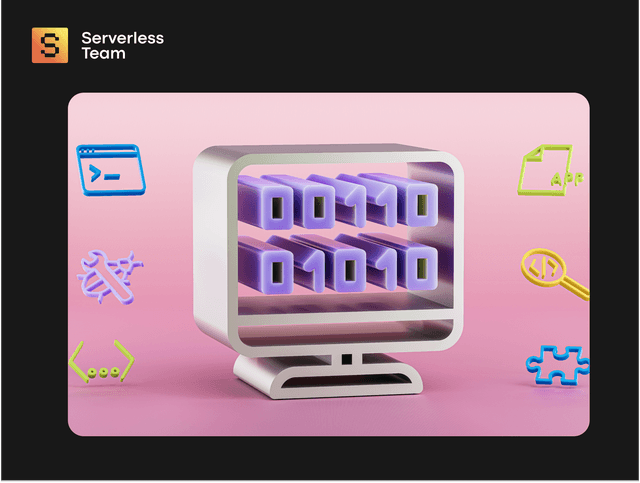Serverless computing: a term that once sounded like a tech oxymoron, has revolutionized how businesses deploy and scale applications. By offloading server management and operations to cloud providers, organizations can focus more on code and less on infrastructure, leading to quicker deployments, reduced costs, and heightened scalability. It's no wonder serverless has become the darling of modern development.
However, with this newfound flexibility comes an often-underestimated adversary: security risks. As serverless architectures dismantle the traditional server model, they introduce a mosaic of potential vulnerabilities, some of which are yet to be fully understood.
In this article, we'll journey into the heart of serverless security, exploring its unique challenges, the increased surfaces for attacks, and best practices to safeguard your applications. A comprehensive guide for a brave new world — read on to ensure your serverless applications aren't just efficient but secure too.

We take care of serverless development so you can focus on your business
Don't want to wait for our site launch? Let's talk about your idea right now.


The Whims and Woes of Serverless Security
Serverless architecture has taken the tech world by storm, like that cool cousin who used to code with just a cup of coffee (we all know at least one). But while it offers incredible scalability, flexibility, and cost savings, it’s not without its quirks — especially when it comes to security.
Before serverless aficionados chant their "infinite scalability" mantra, let’s look at the dark alleyways of AWS serverless security. Because with great power... comes a whole bunch of serverless security challenges.
Common Security Risks in Serverless Architectures

Increased Surfaces for Attack in Serverless Architectures
While celebrated for their scalability and efficiency, serverless architectures have a hidden side to consider: the broadening of potential attack surfaces.
Unlike traditional server-based applications, where you have a single, well-guarded point of entry (your server), serverless functions fan out responsibilities. Every function-as-a-service (FaaS) component effectively acts as a distinct, stand-alone application. This means that for every function you deploy, there's an associated potential entry point for malicious actors.
Let's think of it visually. A traditional server is like a castle with one main gate. Guarding that gate ensures safety for the entire castle. On the other hand, serverless architectures resemble a modern city with multiple points of entry: airports, seaports, highways, and more. Each entry demands its own security checks and monitoring, increasing the complexity.
Additionally, serverless architectures often rely heavily on third-party services and integrations. Each integration introduces a new serverless security risk that could be targeted or exploited if not properly secured. And while providers do invest heavily in security, the decentralized nature of serverless computing inherently creates more potential chinks in the armor.
Security Configuration Errors: The Hidden Doors to Your Data
Security configuration is the unsung hero in the vast universe of serverless applications. Think of the city gates I mentioned earlier. The security configuration stands the guard, ensuring only the right individuals and services get through. However, this guardian can sometimes make mistakes, often in the form of misconfigurations.
Misconfigurations in serverless applications might seem minor at first glance, but they can inadvertently throw open the doors to your precious data. Whether it’s setting incorrect permissions, exposing critical environment variables, or leaving debugging features enabled in a production environment, these seemingly minor errors can provide attackers easy access.
For instance, a wrongly set API endpoint could spill your customer data, or an incorrect IAM (Identity and Access Management) role can give attackers the power to alter your application. In essence, while serverless eliminates some traditional threats, it introduces new ones that need meticulous attention to configuration details.
Proper security configuration is essential. Every single misstep can turn into a potential vulnerability, letting intruders in. Be thorough, be vigilant, and regularly review your configurations.
Authentication Errors: The Frontline Defense of Serverless
Authentication is the age-old practice of ensuring "You are who you say you are." It's the checkpoint at the entrance, where the guard has to verify IDs and grant access. And it is one of the most common serverless security issues, which makes it even more critical.
With a distributed setup involving countless functions, each potentially interacting with different resources, ensuring proper authentication is the cornerstone of security. A lapse in authentication means you're essentially letting anyone waltz into your application, giving them access to sensitive data or even handing them control.
Authentication in serverless goes beyond just user credentials. It encompasses service-to-service authentication, ensuring that only authorized functions or services interact with each other. Without robust authentication mechanisms, serverless applications can become sitting ducks for attackers, making them susceptible to a range of malicious activities.
All-in-all, authentication isn’t just a checkpoint; it's a fortified barrier. Ensuring robust authentication mechanisms in serverless applications is non-negotiable. It safeguards your application’s access points, ensuring only those with the right credentials can get through.
The Risk of Over-Privileged Features: Power You Don’t Always Need
Over-privileged features in serverless are akin to handing over the master key to someone who just needs access to one room. When a function or API in a serverless setup is granted more permissions than it requires, it creates a significant risk. If an attacker manages to compromise that function, they have access to everything that feature is privileged to — even if it’s irrelevant to its primary function.
For instance, if a function designed only to read data from a database can also delete data due to over-privileged settings, an attacker could cause irreversible damage. This goes against the principle of least privilege (PoLP), a cornerstone of IT security, which dictates that users and programs can only access what they need and nothing more.
Over-privileging is an open invitation to trouble. Regularly review permissions, ensure adherence to the principle of least privilege, and keep your serverless applications lean and secure.

Kyrylo Kozak
CEO, Co-founderGet your project estimation!

Serverless Security Best Practices

With their scalability and efficiency, serverless architectures have ushered in a new era in software development. However, with new paradigms come new challenges, especially in security. Thankfully, there are best practices for serverless security to fortify deployments.
Let's dive into these practices, which, when followed, act as robust safeguards for your serverless applications.
- Use API Gateways. API gateways are to serverless applications what moats are to castles: a primary line of defense. Acting as a front door to serverless functions and APIs, they regulate incoming traffic, helping you manage, monitor, and secure it. With capabilities like rate limiting, caching, request validation, and authentication, API gateways significantly enhance your app’s security profile.
- Properly configure IAM roles and permissions. IAM, or Identity and Access Management, is the bouncer of the serverless club. It controls who gets in and what they can do once inside. By meticulously configuring IAM roles, you ensure fine-grained access control to AWS Lambda functions, Azure Functions, Google Cloud Functions, and other serverless offerings. This means each function has only the permissions it needs and nothing more, reducing the risk of overexposure.
- Monitor serverless applications in real time. Imagine having security cameras, but you only review the footage once a month. Sounds risky, right? Real-time monitoring for serverless applications is like having 24/7 surveillance. It allows you to detect threats as they happen and enables you to respond immediately, ensuring any potential damage is mitigated swiftly.
- Reduce your dependence on third parties. Every third-party dependency or service you integrate into your serverless application is like an external door to your home. The more you have, the harder it is to keep track and ensure they're all locked. Limiting third-party dependencies means fewer potential entry points for attackers and fewer things that can go wrong.
- Don't only rely on WAF protection.The Web Application Firewall (WAF) is a fantastic tool. It filters and monitors HTTP requests, blocking malicious ones. However, relying solely on WAF can be misleading. While it’s an essential part of the defense strategy, serverless apps require a multi-layered approach to security.
In essence, while serverless eliminates the concerns of server management, it introduces a web of inter-connected functions and services. It's akin to shifting from guarding a single fortress to patrolling a sprawling city with multiple entry and exit points.
To address serverless cyber security concerns in this expansive landscape, adopting a comprehensive and proactive security strategy is essential. A holistic approach, tailored for serverless nuances, is the best defense against the increased attack surfaces presented by this architecture.
Luckily, it’s precisely what we at Team Serverless specialize in, so get in touch, and we’ll get you covered.
Real World Examples
As you now know, serverless architecture is not immune to security risks. Let’s explore several real-world incidents of security breaches.
- Tesla’s Cloud Infrastructure Compromise: Tesla experienced a security breach in 2018 when attackers infiltrated their AWS serverless environment with malware. By gaining unauthorized access, hackers used Tesla’s infrastructure to mine cryptocurrency illegally.
- Uber’s Data Breach: In 2022, Uber, a ride-hailing service provider, suffered a data leak. A hacker attacked Uber’s third-party asset management and tracking services vendor, Teqtivity, and exposed some corporate information online.
- Attunity-Owned Amazon S3 Buckets Exposed: Three public cloud storage buckets belonging to Attunity leaked over a terabyte of data in 2019. The leaked information included corporate documents, employee details, and passwords of prominent Attunity clients like Netflix, TD Bank, Ford, and more.
Future Trends in Serverless Security
The rapid pace of innovation in the serverless domain indicates a future where AWS serverless security best practices become even more intrinsic and advanced. Here are some notable trends to keep an eye on:
Security by Design: More than ever, security will be integrated right from the application design phase. Instead of being an appended process, security considerations will be a starting point, ensuring apps are built with a robust foundation.
Automated Threat Detection: With the proliferation of AI and ML technologies, automated threat detection will become standard. Systems will predict, detect, and mitigate threats in real time, reducing human intervention and speeding up response times.
Continuous Monitoring and Feedback Loops: Monitoring won’t just be real-time; it will be continuous with feedback loops. This means that every potential threat or breach will be a learning point, further refining the system's defenses.
Serverless Security as Code: Just as Infrastructure as Code (IaC) has become mainstream, expect Security as Code to gain traction. Security configurations and policies will be version-controlled and deployed programmatically, ensuring consistent application across the serverless ecosystem.
Granular Access Controls: Expect even more fine-grained access controls as serverless grows. Systems will enable specific function-level permissions, ensuring each part of your application has only the access it truly needs.
Enhanced Data Protection: With serverless applications interacting with diverse data sources, advanced encryption techniques, both in transit and at rest, will become the norm. Additionally, data masking and tokenization will provide added layers of security.
These trends underscore a future where serverless security isn’t just about guarding against threats but proactively evolving and adapting to an ever-changing threat landscape.
Wrapping up
In the serverless world, security is a dynamic challenge. But by following best practices and staying informed about evolving serverless security risks, serverless applications can be both powerful and secure.
If you're venturing into serverless or looking to tighten your serverless security, remember: knowledge is your armor, and vigilance is your sword. And if you ever need deeper insights or consultation, Our Serverless Team is here to guide and assist.
Don't hesitate to reach out for Serverless Development Consulting, AWS SaaS software solutions or Azure to AWS migration services. Together, we can make serverless secure.





